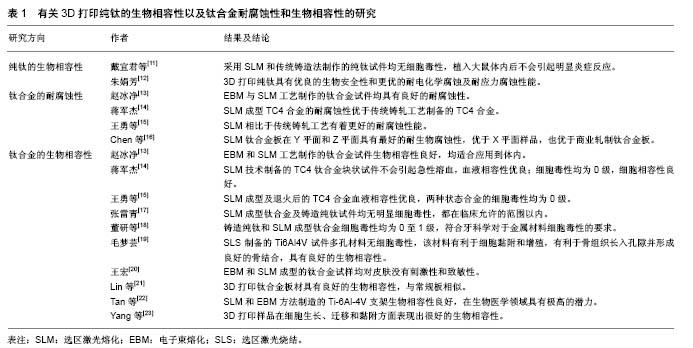| [1] 贾翃,逯福生,郝斌. 2016年中国钛工业发展报告[J]. 钢铁钒钛, 2017,34(2):1-7.[2] 韩建业,罗锦华,袁思波,等.口腔用钛及钛合金材料的研究现状[J].钛工业进展, 2016,33(3):1-7.[3] 梁锐英,李长义,张连云.齿科用钛合金的研究进展[J]. 国外医学(口腔医学分册), 2006,33(1):45-47.[4] 谢辉,张玉勤,孟增东,等.钛合金特性及其在骨科领域的应用现状和研究进展[J].生物骨科材料与临床研究, 2013,10(6):29-32. [5] 张文毓.生物医用钛合金的研究进展[J].化学与黏合. 2014,36(5): 369-373.[6] 陈光霞.可摘除局部义齿支架激光快速成型技术与设备研究[D]. 武汉:华中科技大学, 2009.[7] 陈克南. SLM 3D打印纯钛冠金瓷结合与适合性的基础和临床研究[D].西安:第四军医大学, 2016.[8] 刘一帆,王伟娜,于海,等.选择性激光熔覆(SLM)钛合金可摘局部义齿支架的适合性研究[J].实用口腔医学杂志, 2017,33(3): 302-305.[9] 陈光霞,曾晓雁,王泽敏,等.可摘除局部义齿支架的选择性激光熔化制造技术[J]. 现代制造工程, 2010(6):64-68. [10] 赵丹妹,王春仁,韩倩倩,等.3D打印医用钛合金植入物的研究现状与进展[J].中国医疗器械信息, 2017,23(3):1-5.[11] 戴宜君,董研,周东,等.SLM打印技术对钴铬及钛金属生物相容性的影响[C].第十一次全国口腔修复学学术会议论文. 2017: 33-34.[12] 朱娟芳.激光快速成形技术制作纯钛植入材料的实验研究[D]. 西安:第四军医大学, 2007.[13] 赵冰净.3D打印Ti-6Al-4V理化性能及生物相容性研究[D]. 北京:中国人民解放军医学院, 2016.[14] 蒋军杰.选区激光熔化成型医用Ti-6Al-4V合金的组织和性能研究[D].重庆:重庆大学, 2015.[15] 王勇,蒋军杰,乔丽英,等.选区激光熔化TC4生物腐蚀和生物相容性分析[J].重庆大学学报, 2015,38(3):21-27.[16] Chen LY, Huang JC, Lin CH, et al.. Anisotropic response of Ti-6Al-4V alloy fabricated by 3D printing selective laser melting. Mater Sci Eng A. 2017;682:389-395.[17] 张雷青.基于数字化设计和3D打印的颌骨缺损赝复体修复及3D打印金属材料细胞毒性的初步研究[D].杭州:浙江大学, 2016.[18] 董研,彭伟,张雷青,等.基于选择性激光熔融技术的赝复体支架打印及金属试件细胞毒性的研究[C].第十一次全国口腔修复学学术会议论文.2017:55.[19] 毛梦芸.选择性激光烧结制备多孔钛的机械性能与生物相容性研究[D].济南:山东大学,2016.[20] 王宏. 应用个性化钛合金修复体和同种异体下颌骨修复比格犬下颌骨缺损的比较研究[D].北京:中国人民解放军医学院, 2017.[21] Lin X, Xiao X, Wang Y, et al. Biocompatibility of Bespoke 3D-Printed Titanium Alloy Plates for Treating Acetabular Fractures. Biomed Res Int. 2018;2018:2053486.[22] Tan XP, Tan YJ, Chow CSL, et al. Metallic powder-bed based 3D printing of cellular scaffolds for orthopaedic implants: A state-of-the-art review on manufacturing, topological design, mechanical properties and biocompatibility. Mater Sci Eng C Mater Biol Appl. 2017;76:1328-1343.[23] Yang F, Chen C, Zhou Q, et al. Laser beam melting 3D printing of Ti6Al4V based porous structured dental implants: fabrication, biocompatibility analysis and photoelastic study. Sci Rep. 2017;7:45360.[24] 于华,张晓东,王亦菁,等.口腔金属材料安全性?相容性以及功能性的评价[J].中国组织工程研究, 2012,16(47):8907-8914.[25] 于振涛,余森,张明华,等.外科植入物用新型医用钛合金材料设计?开发与应用现状及进展[J].中国材料进展, 2010,29(12):35-51. [26] 于振涛,余森,程军,等.新型医用钛合金材料的研发和应用现状[J]. 金属学报, 2017,53(10):1238-1264. [27] 罗丽娟,余森,于振涛,等. 3D打印钛及钛合金医疗器械的优势及临床应用现状[J].生物骨科材料与临床研究,2015,12(6):72-75.[28] 任继文,刘建书.选择性激光烧结主要成型材料的研究进展[J]. 机械设计与制造, 2010,48(11):266-268.[29] Venkatesh KV, Nandini VV. Direct metal laser sintering: a digitised metal casting technology. J Indian Prosthodont Soc. 2013;13(4):389-392. [30] 谭兆军,郭亚峰.口腔修复用钛及钛合金的理化特性及其生物相容性[J].中国组织工程研究与临床康复, 2008,12(19): 3721-3724.[31] 李洋,陈长军,王晓南,等.医用多孔钛及钛合金的研究进展[J].现代制造工程, 2015(7):144-148. [32] Tian Y, Yu Z, Ong CY, et al. Microstructure, elastic deformation behavior and mechanical properties of biomedical β-type titanium alloy thin-tube used for stents. J Mech Behav Biomed Mater. 2015;45:132-141.[33] Butscher A, Bohner M, Hofmann S, et al. Structural and material approaches to bone tissue engineering in powder-based three-dimensional printing. Acta Biomater. 2011;7(3):907-920. |
.jpg)

.jpg)
.jpg)